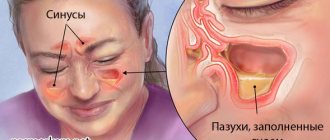Causes of cough with green sputum and their characteristics
Most respiratory diseases are accompanied by activation of the cough reflex. It occurs in response to irritation of sensory receptors in the ENT organs by dust, pathogens, allergens, etc. A cough with green sputum indicates the nature of the inflammatory processes. Laboratory testing reveals dead immune cells and pyogenic bacteria – Klebsiella, meningococcus, staphylococcus, etc. – in the mucus.
Pneumonia
This disease of bacterial etiology is accompanied by damage to the alveoli and inflammation of the lung tissue. Pneumonia is caused by various bacteria:
- staphylococcus;
- Pneumococcus;
- Klebsiella;
- streptococcus, etc.
This is indicated by thick yellowish sputum released when coughing. Typical manifestations of the disease include:
- coughing attacks;
- chest pain;
- temperature increase;
- hard breathing;
- wheezing in the lungs.
Green mucus when coughing indicates suppurative processes in the lower respiratory tract.
Pneumonia requires antibacterial treatment, since untimely destruction of the infection leads to complications - respiratory failure, pulmonary edema, pleurisy.
Bronchiectasis
Coughing up green mucus in the morning in some cases indicates bronchiectasis. Most often it occurs against the background of other ENT pathologies:
- pneumofibrosis;
- pulmonary tuberculosis;
- bacterial pneumonia.
For a long time, the disease does not cause much discomfort, but in the spring and autumn the inflammation worsens. This is indicated by the following symptoms:
- spasmodic cough upon waking;
- green thick sputum;
- dyspnea;
- cyanosis (blue discoloration) of the skin;
- fast fatiguability;
- moist rales in the lungs.
In the first hours after waking up, a large amount of purulent mucus is released. Patients also complain of putrid odor from the mouth and a feverish state.
Bronchitis
Inflammation of the bronchi of bacterial origin is accompanied by a cough with the discharge of green, viscous mucus. The disease is caused by pyogenic bacteria - Haemophilus influenzae, streptococcus, pneumococcus. When a child or adult coughs, green or light yellow sputum is coughed up. The appearance of the disease is also indicated by:
- heat;
- coughing attacks;
- fatigue;
- apathy;
- elevated temperature;
- headache.
With timely treatment, acute bronchitis lasts 10 days. Sometimes it occurs against the background of other diseases - influenza, tracheitis, tonsillitis. Delayed therapy is fraught with the transition of acute inflammation to a chronic form.
Abscess in the lung
Abscess pneumonia is characterized by the formation of cavities inside the lung with green purulent fluid. The disease is caused by pathogenic microorganisms:
- klebsiella;
- Staphylococcus aureus;
- Pfeiffer stick (haemophilus influenzae), etc.
A lung abscess is accompanied by severe poisoning of the body, which causes:
- cough with fever;
- fever;
- malaise;
- chest pain;
- chills.
When ulcers rupture in the lungs, green sputum is coughed up, which sometimes contains blood impurities.
Tuberculosis
The disease occurs when the lungs are damaged by Mycobacterium tuberculosis. The clinical picture is determined by the person’s immune status and associated complications.
Green sputum during a cough without fever remains the only manifestation of tuberculosis for a long time. As the inflammatory process progresses, the following symptoms occur:
- weakness;
- sweating;
- fatigue;
- enlarged lymph nodes;
- low temperature;
- weight loss.
Tuberculosis is accompanied by a wet cough, wheezing in the lungs, chest pain and hemoptysis.
In some cases, a cough with green sputum indicates the formation of low-quality tumors in the lungs. Symptoms of bronchogenic carcinoma (lung cancer) are determined by the location of the tumors. Often the pathology is asymptomatic until the tumor affects the pain endings in the lung. Its appearance is also indicated by:
- hoarseness of voice;
- mucus with blood when coughing;
- dyspnea;
- weight loss;
- deformation of the fingers (symptom of “drum sticks”).
Due to the weakening of local immunity and purulent pneumonia, sputum is released when coughing, in which green clots of pus are found.
Other reasons
Expectoration of green or yellow mucus in 93% of cases indicates infectious inflammation of the respiratory system and purulent complications. A severe cough with green or yellow sputum is a symptom of the following diseases:
- sinusitis;
- adenoiditis;
- cystic fibrosis;
- purulent pleurisy;
- bacterial tracheitis;
- helminthic infestations;
- pulmonary infarction.
Purulent inclusions in bronchopulmonary secretions are an alarming symptom indicating bacterial inflammation of the ENT organs. Pathologies require adequate and timely treatment, since the lack of antimicrobial therapy is fraught with life-threatening complications.
Treatment methods for children and adults
The scheme of treatment depends on the factors that provoked increased separation of the mucous substance. Drug therapy involves the prescription of drugs from the following groups:
- antibiotics used to suppress pathogenic microflora that provoke the formation of mucus (Lincomycin, Augmentin, Clarithromycin, Unidox, Cefroxime, Doxycycline, Sumamed, Flemoxin);
— expectorants (Bromhexine, Ambroxol, Pertussin, Lazolvan, Flavamed, Ambrobene);
- mucolytic agents that thin out a dense, viscous mass and facilitate its removal (ACC, Fluditek, licorice root syrup, Fluimucil, Pectolvan, Libexin Muco, Mucaltin, Prospan);
- antihistamines: Zodak, Loratadine, Allergodil, Erius, Claritin, Fenistil, Suprastin, Cetirizine;
— immunomodulators: Aflubin, Amiksin, ginseng tincture, echinacea, Anaferon, Umkalor, Immunal.
In addition to drug therapy for diseases accompanied by the discharge of green secretions, home procedures are effectively used in adult patients.
- Warming drink.
Add a pinch of salt, a little butter to ¾ mugs of freshly brewed tea and stir. Add milk until the mug is completely filled. Drink the resulting hot drink slowly so as not to burn your throat. Drinking the drink significantly facilitates the outflow of pathogenic suspension, making coughing softer.
- Warming compress.
You can use mustard plasters or jars or make a compress from bread. To do this, wrap black bread with honey in several layers of fabric. Applied to the patient’s chest, the composition stimulates the independent removal of mucous substance, and also promotes restful sleep.
- Chest massage. Technique: slow circular movements across the chest. Instead of massage oil, a healing composition is recommended, for example, an infusion of pine buds.
- Inhalations. A well-known folk method is steam inhalation of hot potatoes. The use of infusions of medicinal herbs (chamomile, eucalyptus, brewed pine buds, breast milk) is also effective.
It is recommended to drink plenty of warm drinks, walk in the fresh air (if there is no high temperature), frequently ventilate the home, and humidify the air. Mandatory bed rest is provided.
All of these techniques have a beneficial effect on the patient’s condition and allow for a fairly quick recovery with minimal risk of complications.
It is comparatively more difficult to treat cough in expectant mothers. But it is for them that treatment is most important: coughing attacks can tone the uterus and cause premature birth (miscarriage). Therefore, during pregnancy, it is necessary to consult a doctor to select approved medications: self-medication is unacceptable here.
If similar symptoms are detected in a child, only the pediatrician should decide how to treat him. Special massage is usually added to drug therapy:
- The baby is placed on his tummy on his mother's lap with his hands on the floor and his legs raised up.
- Warm up the baby's back with gentle movements.
- Using the pads of your fingers, do a tapping massage on your back. In this case, the blows should be soft and painless.
After the procedure, the child expectorates a large amount of green sputum, and subsequently coughing becomes much easier.
Parents should monitor the child's compliance with bed rest. It is advisable to pay special attention to the baby’s nutrition. You cannot force your baby to eat if he has no appetite. The fact is that during illness, a child’s body uses all its strength to fight infection, and digesting food requires a redistribution of energy costs, which reduces the effectiveness of the fight.
How to diagnose
A treatment regimen for the disease is drawn up only after the causative agent of the infection has been identified. Diagnosis of cough with green sputum involves consultation with highly specialized specialists (TB doctor, ENT doctor, pulmonologist, infectious disease specialist), laboratory and hardware examination:
- Ultrasound of the chest organs;
- radiography;
- CT scan;
- clinical blood test;
- bronchoscopy;
- culture of sputum for microflora.
To exclude bronchogenic carcinoma, a blood test is performed for tumor markers, and if pneumonia is suspected, a lung biopsy and computed tomogram are prescribed.
Features of treatment
Treatment of green sputum when coughing involves the use of antibiotics and medications aimed at eliminating symptoms.
Bacterial inflammation is eliminated with two types of drugs:
- etiotropic (affecting the cause of the disease) - in this case, antibiotics;
- symptomatic – antitussive, expectorant, analgesic, etc.
Antibiotics for coughs destroy pathogenic flora in the ENT organs, thereby eliminating inflammation and green bronchopulmonary mucus.
Pharmacy medicines
How to treat respiratory diseases depends on the cause of their occurrence. If green sputum is produced when coughing, use the following medications:
- expectorants (Pertussin, Flavamed, Gerbion) – remove mucus from the bronchi and upper respiratory tract;
- antiallergic (L-Cet, Claritin, Zyrtec) – eliminate swelling, itching and burning in the throat;
- mucolytic (Pectolvan, Mucaltin, Acetin) - liquefy green, difficult to separate sputum;
- immunostimulating (Immunorix, Lavomax, Umkalor) – increase the body’s resistance to bacteria and viruses;
- antibiotics (Unidox, Hemomitsin, Augmentin) - destroy the bacterial flora in the ENT organs and at the same time, unfortunately, in the intestines.
Taking antibiotics for a cough eliminates the cause itself, that is, a bacterial infection. Symptomatic medications remove green, viscous mucus from the respiratory tract. When taking antibiotics, dysbacteriosis cannot be ruled out. Therefore, the treatment regimen includes drugs that restore intestinal microflora - Bionorm, Bifidumbacterin, Picolax.
Physiotherapy and drainage massage
Physiotherapeutic treatment is aimed at restoring the self-cleaning mechanism of the bronchi. Hardware procedures stimulate the removal of green mucus and eliminate coughing. To improve well-being during bronchitis, tracheitis, pneumonia, the following are used:
- UHF therapy – relieves inflammation and bronchospasms, reduces chest pain, increases local immunity;
- magnetic therapy - eliminates swelling and increases the lumen in the bronchi, stimulates expectoration of green viscous sputum;
- electrophoresis – prevents inflammation of the respiratory system, relieves swelling, enhances the effect of medications;
- Ural irradiation - disinfects mucous membranes, restores blood circulation in the ENT organs.
To eliminate cough with sputum without fever in an adult, drainage massage is used. Before the procedure, the patient is given expectorant tablets to facilitate the passage of mucus from the lungs. Manual therapy sessions are carried out 1-2 times a day to quickly restore the drainage function of the bronchi. The massage is performed taking into account the following rules:
- the patient is placed on his stomach so that the chest is above the head;
- rub your back for 3-7 minutes, making movements in the direction of your head;
- to activate breathing, gently tap the ribs with the pads of your fingers;
- Finally, they rub so that the palms slide only in the direction from the lower back to the neck.
After the massage, patients are asked to stand up and take a deep breath. This promotes coughing and expectoration of mucus.
Home Remedies Therapy
Traditional medicine is recommended to be used in the fight against diseases of the ENT organs in the absence of high fever. Paroxysmal cough with discharge of green purulent sputum is treated with herbs and foods that have mucolytic properties.
Effective remedies include:
- Phytocollection. 5 g of coltsfoot and lungwort are mixed with 25 g of mallow flowers. Pour the mixture of herbs into 1 liter of vegetable oil and leave for at least 3 days. For spasmodic cough with discharge of green mucus, take 50 ml 5 times a day.
- Decoction of marshmallow. 10 g of the plant is poured into 250 ml of water and boiled in a steam bath for 10 minutes. The strained liquid is taken on an empty stomach, 150 ml per day.
- Ginger with sugar. 3 tsp. chopped ginger root and 200 g of sugar. The thoroughly mixed mixture is taken 1 tsp. 20 minutes before meals 3-5 times a day.
In case of complicated bacterial diseases, herbal medicines should be taken only after the doctor’s approval.
Treatment of green sputum when coughing
When treating viral and bacterial infections complicated by congestion, drug treatment, physiotherapy are used, and, if necessary, surgical intervention is performed (abscesses are opened, tumors are removed).
Antibiotics, mucolytics (Ambrobene, Mukobene, Lazolvan), bronchodilators (Theophylline, Atrovent, Berotec), expectorants (Ambroxol, Codelac Broncho), anti-inflammatory and antipyretic (Ibuprofen, Paracetamol), immunostimulants (Bronchomunal) must be used.
Treatment in an adult and a child, although the basic principles are similar, differs in detail: in pediatrics, more gentle methods, lower concentrations and a reduced dosage of drugs are used.
If examination reveals a bacterial etiology, antibiotics are used for treatment. Macrolide drugs such as Azithromycin and Clarithromycin are considered the most effective. Their advantage lies in their broad antimicrobial activity; they suppress the vital activity of legionella, mycoplasma, and chlamydia.
During antibiotic therapy, the dosage is strictly observed and the course of treatment is maintained. If the sputum does not change its color (green, dark green) and your health does not improve, you need to choose other medications.
If the patient does not have a fever, warming agents can be used. These can be mustard plasters and warming compresses. In any condition, decoctions, infusions and herbal teas, plenty of warm and alkaline drinks are useful.
When cough and sputum are caused by ARVI or bronchitis, and the accumulated consistency is difficult to expectorate, the doctor prescribes treatment using special mucolytic agents that dilute the sputum. Also, in case of difficult to separate sputum, expectorants are prescribed.
Many people, worried about their health, sometimes refuse to take medications, preferring folk remedies. However, it must be taken into account that such treatment methods may also have contraindications and cause side effects. Therefore, before starting treatment, you should consult with your doctor.
It is also important to understand that mucolytic and antitussive drugs cannot be taken at the same time, otherwise the patient’s condition will only worsen.
Medicines that relieve cough are divided into three main groups:
- Expectorants are prescribed to treat cold symptoms with thin sputum.
- Antitussive drugs are prescribed when it is necessary to treat non-productive and dry cough.
- Mucolytic drugs are used when it is necessary to treat symptoms of thick, viscous, and difficult to clear sputum.
Treatment of diseases that provoke the described symptom requires an integrated approach. Medication and physiotherapeutic methods are used to improve the patient’s health. The use of traditional medicine is allowed.
The correct approach to treatment involves influencing the root cause of the disease. Additionally, it is recommended to quit smoking. The patient must eat well to provide the body with sufficient amounts of proteins, fats and carbohydrates.
Mucolytic and expectorant drugs play one of the key roles in the patient’s health. The main goal is to thin the mucus and speed up its removal from the respiratory tract.
To achieve this result, the following means are used:
- Ambroxol;
- Bromhexine;
- Alteyka;
- Stoptussin Phyto;
- Gedelix;
- Gerbion and others.
How dangerous is the condition?
Green discharge from the respiratory tract when coughing indicates the proliferation of pathogenic bacteria in the body. Their untimely destruction causes serious complications:
- emphysema;
- pleurisy and pleural empyema;
- respiratory failure;
- gangrene of the lung;
- meningitis;
- endocarditis;
- sepsis.
A bacterial infection leads to intoxication, that is, poisoning of the body with toxic substances. This increases the risk of bronchial obstruction (narrowing), swelling of the airways, and suffocation.
Prevention
To prevent cough with green sputum in adults, it is necessary to promptly treat ENT diseases. The likelihood of their occurrence depends on the person’s immune status and lifestyle. To reduce the risk of bacterial diseases, you must:
- take vitamin and mineral complexes;
- avoid hypothermia and overheating;
- stop smoking;
- take medicine when you have a cough;
- wash your hands regularly with antibacterial soap;
- take immunostimulants in the spring and autumn;
- include vegetables, fruits and dried fruits in the menu;
- humidify the air in the room.
Many diseases occur as a result of decreased immunity caused by mineral or vitamin deficiency. Correction of nutrition, intake of dietary supplements and vitamins increase the body's resistance to infections and prevent purulent inflammation of the respiratory tract.
source
Preventive measures
In order to prevent the manifestation of such symptoms, it is necessary to begin treatment measures in the early stages of damage to the upper respiratory tract, avoiding congestion of the bronchopulmonary sphere, and strictly follow the recommendations of doctors.
Patients who frequently suffer from such ailments should take special precautions.
Additional preventive measures are strengthening the immune system through hardening, taking immunomodulators, vitamin complexes, moderate physical activity, maintaining optimal air humidity in the bedroom, and quitting smoking.
Green phlegm coughing up: what to do? Causes and treatments
Green sputum when coughing is far from uncommon, since many different diseases manifest themselves this way.
But let's start with the fact that coughing as such is a natural reaction of the body,
even an unconditioned reflex that occurs in response to dust, liquid, or accumulation of secretions in the respiratory organs.
Therefore, it should not be considered as a cause of a disorder in a person’s condition, or even less of an illness.
It acts as one of many symptoms of various pathologies and, in fact, helps a person survive, so you need to be able to deal with it correctly.
Main reasons
Discoloration of the discharge in a greenish tint is a serious reason to make an appointment with a doctor for a proper diagnosis. The most common diseases that provoke its formation are the following:
- purulent bronchitis or exacerbation of chronic bronchitis - a severe form of colds of the bronchopulmonary system;
- pneumonia – complicated inflammation of the lungs;
- purulent pleurisy, developing due to infection of the pleural cavity;
- lung abscess resulting from bronchial obstruction;
- asthma;
- inflammatory processes in the upper respiratory tract (sinusitis, adenoiditis, laryngitis and others);
- tuberculosis;
- oncological phenomena in the respiratory system.
In addition, one of the reasons that causes the production of secretions of this color is smoking.
The volume of fluid released varies depending on the severity of the pathology and the source of inflammation. The greatest amount is released in the morning. The body, with the help of morning coughing, tries to release the pathogenic microflora accumulated during the night.
If adequate therapy is not started in time, complications are inevitable within a few weeks, sometimes even death.
Green mucus coughing up: what is it?
Sputum is a direct result of the formation of an inflammatory process in the trachea, bronchi, lungs, etc. It is a mucous discharge of different consistency and color.
The released secretion contains particles of dust, dead tissue of the mucous membrane, destroyed pathogens (viruses, bacteria, fungi, etc.), as well as dead immune cells.
Depending on which components predominate in its composition, the discharge takes on one or another shade.
It can be yellow, greenish, brownish, streaked with blood, transparent, foamy, hard, have a repulsive putrid odor, etc.
Moreover, it is its color and character that often helps doctors make the correct diagnosis and choose the most appropriate treatment for the situation.
A cough with green sputum and green snot is very common. What this means is usually easy for a therapist or pediatrician to understand, since it is most often a sign of a bacterial infection, although there are exceptions.
It is the destroyed microbial cells and leukocytes produced in increased numbers (cells that purposefully destroy pathogenic bacteria) that give the discharge a greenish color.
Depending on the type of microorganism that caused the illness, the shade of the secretion may change from grass-green to brown-green.
Why do you cough up green mucus?
Normally, healthy adults can expectorate mucus from the respiratory tract in the morning; it should be clear and free of impurities. If you cough up green, purulent sputum, you should get diagnosed and begin treatment.
The human respiratory tract is designed in such a way that the mucous membrane lining it from the inside constantly produces liquid secretions. It envelops any particles entering the bronchial tree due to local immunity antibodies that bind inhaled bacteria in a timely manner. The mucosa also contains ciliated cells that have projections on the side facing the inside of the respiratory tract. By the synchronized actions of these cilia, foreign particles and infectious agents are pushed out, which is complemented by natural exhalations and cough shocks. Green expectorated sputum does not occur when a healthy person coughs, so it must be treated.
You might be interested in the article - Why does a cough with phlegm appear in the morning?
Normally, the cleansing of the respiratory system occurs due to the movement of mucus. To ensure the work of the cilia, the secretion must be of a certain thickness. If it is more liquid, they work “idle”; if it is thick, they cannot budge. Thus, foreign elements remain in the respiratory tract, supporting or causing an inflammatory process. Green, thick sputum may appear when you cough . The absence or presence of elevated temperature depends on the activity of inflammation.
In pathology, when the secretory function of the glands of the respiratory tract is disrupted, the secretion accumulates in the form of thick viscous mucus, called sputum. It does not go away easily on its own, forms plugs, and clogs the bronchi. The infection develops intensively in it, which supports the inflammatory process, in which blood cells - leukocytes (macrophages, neutrophils, lymphocytes) participate.
Dead leukocytes and putrefactive infection form pus and give the sputum a greenish color. As stagnation occurs, the condition worsens, the temperature may rise, and chills may appear. The main symptoms of the problem are cough and purulent green sputum. .
What does the color of sputum indicate?
Obviously, in most situations, green mucus when coughing indicates a primary or secondary bacterial infection.
Therefore, its appearance is considered a good reason to make an appointment with a doctor, since the lack of proper treatment can become a reason for the development of complications, including pneumonia, etc.
If you experience a cough with green sputum, you should definitely pay attention to its shade, as this will help determine the severity of the condition and select appropriate therapy for the situation.
Yellow-green - can indicate the appearance of pus or, conversely, the completion of the inflammatory process and the beginning of recovery.
If such discharge from the lungs or bronchi is expelled by expectoration at the beginning of the acute period of the disease, it is necessary to consult a doctor as soon as possible, since the discharge of pus requires immediate qualified treatment.
If yellow-green discharge occurs when all the symptoms of the disease have subsided, this is a sign of positive dynamics and is a reason to continue the therapy started.
By the way, the appearance of blood streaks should not frighten the patient too much, since they are often only a consequence of mechanical damage to the smallest blood vessels during the next coughing attack.
The presence of blood is much less common, but in such situations, patients, among other things, will have morning fever, rapid weight loss, etc.
In completely healthy people, colorless sputum is observed in small quantities, easily separated in the morning. But it should not be confused with the glassy transparent discharge typical of asthma. Source: nasmorkam.net
What does the color of the discharge indicate?
When coughing with green sputum, you should pay attention to its color characteristics.
- Transparent or yellowish, liquid, abundantly secreted - characteristic at the initial stage of a viral attack.
- Unpleasant-smelling, yellow-green, clotted sputum indicates the presence of pus. May indicate the beginning of the recovery stage. If purulent sputum appears at the onset of the disease, you should immediately seek medical help, as this is a clear sign of congestion in the lungs.
- The dark green color of the discharge containing lumps is characteristic of cystic fibrosis.
- The red tint comes from the presence of blood in it. The prerequisites for its appearance are mechanical damage to the capillaries during severe expectoration. High levels of blood require urgent medical attention as they are likely the result of pulmonary hemorrhage.
- Brownish-green sputum with a prolonged cough with high fever is present in pneumonia.
- Gray-green, especially dirty gray, is possible with tissue necrosis, indicating the likelihood of an oncological factor.
- A colorless liquid in small quantities with no signs of inflammation is a normal bronchial secretion.
Green sputum when coughing: causes
The main reason that a cough develops with expectoration of greenish mucus is bacterial infections, which usually occur with a temperature of 37°C. There are:
- tracheitis;
- laryngitis;
- bronchitis of different types;
- pneumonia, etc.
Also, expectoration of green clots is often present in smokers. Nicotine pathology makes itself felt by coughing attacks, during which a greenish-brown viscous secretion is released.
Often, green mucus in the throat does not appear as a result of damage to the lower respiratory tract, but due to the development of an inflammatory process in the paranasal sinuses (sinusitis or other types of sinusitis) or exacerbation of adenoiditis.
In such cases, it flows down the back wall of the nasopharynx and irritates the throat, which provokes a cough reflex, resulting in the coughing up of green mucus.
In rare cases, green sputum in the throat indicates the development of cystic fibrosis, tumors, tuberculosis and some other serious pathologies.
Diagnosis of green sputum during cough: which doctor should I contact?
As a rule, diagnosis is not difficult. To determine the pathology, you need to make an appointment with a therapist who will listen to the lungs and bronchi, examine the throat, lymph nodes, etc.
Based on the data obtained, he will be able to immediately tell what the greenish mucus is talking about, or prescribe additional studies, for example, bacteriological analysis of the discharge.
This will allow you to isolate the causative agent of inflammation and diagnose bronchitis, tracheitis, pneumonia, etc.
However, sometimes viscous green mucus is released from the nasopharynx or is present when expectorated only at a specific time of day.
Then an important diagnostic sign is when a cough with green sputum appears. If it occurs mainly in the morning, it may be a symptom of:
Sinusitis is an inflammatory disease of the mucous membranes of the paranasal sinuses. Most often, patients are diagnosed with sinusitis (damage to the maxillary or maxillary sinuses), somewhat less frequently ethmoiditis, sphenoiditis and frontal sinuses.
In such conditions, mucus often does not leave the affected sinuses during the day, which provokes a feeling of fullness in them, headaches and an increase in body temperature up to 38 ° C and above.
Overnight, the outflow normalizes, and the accumulated greenish mucus exits into the nasopharynx, which is why a cough reflex may occur, although usually the disease occurs without coughing.
If attacks occur constantly throughout the day, including at night, you should look for the causes of the disorder in the lower respiratory tract.
To understand in which part of the respiratory system inflammation has appeared, you should pay special attention to the nature and consistency of the discharge.
So, scanty, thick, stringy or hard sputum that is difficult to remove may be a sign of:
- cystic fibrosis, but in this case there must certainly be changes in the condition of the liver, intestines and pancreas;
- bronchial asthma - an important diagnostic sign is difficulty in exhaling and the abrupt end of an attack, but the discharge is colorless;
- severe tracheitis, which is characterized by frequent, debilitating attacks that bother a person day and night.
Thus, people with similar symptoms should first contact a general practitioner or pediatrician (if they occur in children).
The doctor will be able to assess the patient’s condition and competently explain what the appearance of such disorders means.
- consultation with an infectious disease specialist, pulmonologist, phthisiatrician, allergist and other specialized specialists;
- Ultrasound;
- X-ray;
- CT;
- MRI, etc.
If you cough up green sputum: treatment
How to treat a disease depends on the causes of its occurrence.
At the same time, patients are often recommended not only classical drug therapy, but also a number of special procedures that can be easily performed at home.
For bacterial infections, antibiotics are prescribed (Augmentin, Flemoxin, Lincomycin, Unidox, Sumamed, Azithromycin, Cefix, Cefuroxime, Hemomycin, Ampiox, Doxycycline, Clarithromycin, etc.), which will help get rid of pathogenic microflora, as well as:
- mucolytics: ACC, Fluimucil, Mucaltin, Carbocysteine, Fluditec, Pectolvan, Prospan, Acetin, licorice root syrup, Libexin Muco;
- expectorants: Ambroxol, Lazolvan, Ambrohexal, Ambrobene, Gedelix, Bromhexine, Flavamed, Doctor Mom, dry medicine, Pertussin, Herbion primrose syrup;
- antihistamines: Zodak, Erius, L-cet, Suprastin, Edem, Loratadine, Claritin, Tavegil, Aleron, Alergodil, Fenistil, Cetirizine;
- immuno-strengthening: Umkalor, Aflubin, Isoprinosin, Lavomax, Oscilococcinum, Amiksin, Anaferon, Immunal, Proteflazid, Immunorix, Derinat, tinctures of echinacea, ginseng, lemongrass, etc.
It would not be superfluous to carry out inhalations using a nebulizer or improvised means, for example, a pan of boiled potatoes.
What medications should be used for inhalation therapy in a nebulizer are prescribed to the patient by the doctor; as part of self-medication, only saline solution is allowed.
Inhalations are equally useful for both tracheitis and bronchitis. They help to liquefy the viscous secretion accumulated in the bronchi and help when the throat hurts, due to the softening effect on the mucous membrane.
If there is no fever, it is useful for patients to walk in the fresh air. Required:
- ventilate the room;
- drink plenty of warm drinks;
- use household humidifiers.
More serious pathologies, such as tuberculosis, are treated in hospitals according to specially developed schemes.
Cough with green sputum in adults
Treatment of colds in adults requires bed rest, as otherwise undesirable consequences may develop.
This will allow you to cure the disease in the shortest possible time with minimal risk to the body.
It is much more difficult to carry out therapy for expectant mothers. Nevertheless, it is they who need it in the first place, since frequent coughing attacks can increase the tone of the uterus and in certain women provoke the threat of miscarriage.
Therefore, during pregnancy, self-medicating and not paying attention to the problem is strictly prohibited.
In such cases, you should definitely contact a therapist, who will select medications that are acceptable for this period.
Child coughs up green mucus
As a rule, pediatricians recommend supplementing drug treatment for a child with a special massage:
- The baby is placed on his stomach on the adult's lap, while he must rest his hands on the floor and raise his legs as high as possible.
- An adult initially rubs the baby's back with light movements until a feeling of warmth and barely noticeable redness appears.
- Using light tapping movements with the fingers of a relaxed hand, the adult begins to actively hit the child’s back for several minutes. It is very important to control the force of the blow: they should be noticeable, but not painful.
The effectiveness of this massage has long been proven. Most children begin to cough more easily within a few minutes of completing the procedure. Here's a video:
If the baby has a fever, parents should pay special attention to ensuring that the baby remains in bed until the body temperature normalizes. Nutrition is also important.
You should not force feed your child if he refuses to eat. During illness, the body spends all its energy fighting microbes, and eating food leads to a redistribution of energy costs and a decrease in the quality of the fight against infection.
Treatment of cough with green sputum
After clarifying the diagnosis, a comprehensive treatment is prescribed that can suppress the development of pathogenic microflora, enhance and accelerate the removal of mucus, and restore and strengthen the immune system.
Medicines
For green discharge from the lungs and upper respiratory tract, the following are treated:
- Antibiotics. The drugs destroy colonies of bacteria that cause the infection. Medicines block protein synthesis in microbes and destroy aminoacyl-RNA transport bonds, which causes the death of pathogens. Augmentin, Flemoxin, Lincomycin, Sumamed, Cefix, Doxycycline, Clarithromycin are used. Antibiotics are used to suppress diseases that produce bright green, rusty or gray mucus.
- Mucolytics. Medicines dilute pulmonary secretions, reduce the viscosity of dense lumps, and accelerate the evacuation of pathogenic mucus. Protect cells from oxidation, suppress inflammation, neutralize toxins in tissues. For pneumonia, cystic fibrosis, bronchiectasis, acute respiratory infections, take ACC, Fluimucil, Mucaltin, Carbocysteine, Fluditek, Pectolvan.
- Medicines with an expectorant effect. The drugs stimulate respiratory tract motility and liquefy hard clots of pus. Activate the production of sputum, facilitate the removal of pathogens. For colds and lung diseases they are treated with Ambroxol, Lazolvan, Ambrohexal, Bromhexine.
- Antihistamines. Medicines relieve inflammation and allergic reactions that cause coughing. For allergies with the formation of pathogenic mucus, Zodak, Suprastin, Loratadine, Claritin, Tavegil are used.
- Immunomodulators. The drugs eliminate intoxication, relieve inflammation, and strengthen the immune system. They drink Umkalor, Aflubin, Immunal, Anaferon. Medicines are used for ARVI, pneumonia, bronchitis.
Anaferon is a drug that eliminates intoxication
How to get rid of green sputum using folk remedies?
Folk remedies alleviate the course of diseases with the formation of green mucus.
- Warming cocktail. Add salt, butter and 50 ml of milk to a glass of strong, freshly prepared tea. The product is consumed hot. Drink tea, taking small sips. The drink thins thick secretions and accelerates the outflow of pathogenic substances.
- Compress. Boiled potato tubers are mashed, soda, black bread and honey are added to the puree. The mixture is distributed over a canvas napkin, placed on the chest, and insulated with a bandage. The application warms, thins mucus, dilates the bronchi, pushes purulent plugs into the throat, soothes, and makes it easier to fall asleep.
- Mustard plasters. The application product is sold in pharmacies. Mustard plasters are moistened in warm water and placed on the back. Hold for 10 minutes. When heated, the blood vessels dilate, the cough becomes productive, and the bronchi are cleared of excess mucus.
- Breast massage. Make smooth circular movements along the chest. When massaging, rub lemon, mint or eucalyptus oil into the skin. Add 2 drops of ether to 5 ml of vegetable oil and use for massage. Oils strengthen the immune system, relieve inflammation, have antibacterial and antiviral effects, and accelerate the release of sputum.
- Inhalations. The procedure is done with soda or salt (dissolve 1 tablespoon of the substance in 1 liter of water), essential oils (add 5 drops of mint or eucalyptus oil per 1000 ml of water). Healing vapors are inhaled through the mouth slowly and deeply, covered with a blanket. Inhalations are done if you have a sore throat, a cough, a cold, or respiratory diseases. The course of treatment is 10 procedures.
- Herbal teas. St. John's wort, mint, sage, plantain, coltsfoot fight cough and snot. For infusion or tea, take 200 ml of boiling water, add 1 tsp. any herb, leave for 15-20 minutes. Take 3 times a day, 1 glass. Treatment lasts 2-4 weeks.
- Red juice with honey. The root vegetable is cut in half, part of the pulp is removed, filled with honey, and the juice is allowed to stand out. Use 1 tbsp. l. 3 times a day. Duration of treatment is 15-30 days. The product is effective for productive cough.
- Drinking regime. A person who coughs with phlegm needs to drink plenty of fluids. The liquid reduces the viscosity of sputum and increases expectoration.
- Saline solution to remove stagnation. If you cough with mucus, you should relieve nasal congestion. Exudate seeps through the nasopharynx into the bronchial trunk. Accumulating exudate causes congestion in the respiratory canals. The substance is removed by rinsing the nasal passages with a saline solution. To clean a child’s nose, take ¼ tsp per 1 glass of water. sodium chloride. For adults, double the amount of salt: dissolve ½ tsp in 200 ml of water. substances.
Drinking plenty of fluids will reduce the viscosity of sputum
If a cough with green sputum is accompanied by an increase in temperature, avoid ointments with a warming effect, compresses and mustard plasters.
Green sputum when coughing without fever: treatment
Sometimes people complain that they cough up green sputum but have no fever. This could be a manifestation of any of the diseases listed above and indicate either a mild form of infection or a severe weakening of the immune system. [ads-pc-1][ads-mob-1] But also a cough with green sputum against a background of normal temperature can be a consequence of:
- penetration of a foreign object into the respiratory tract;
- exposure to toxic compounds;
- helminthic infestation;
- some sexually transmitted diseases.
If the problem does not go away on its own within a week, it is necessary to consult a doctor who will help determine the cause of the condition and select the appropriate treatment.
What does the appearance of green sputum mean when coughing in adults and children?
When a dry cough becomes productive, some believe that the person is on the mend. In reality, everything is somewhat different: the nature of what is separated is important. If green sputum comes out when you cough, there is a good reason to see a doctor. Such a symptom can be a signal of a serious pathology in the bronchopulmonary system or upper respiratory tract.
Why does the color and consistency of discharge change?
If a sick person coughs up thick green sputum, this indicates a complex inflammatory process that may affect the bronchi, lungs, trachea and other organs. In addition to microparticles of dust, dead particles of mucous tissue, it contains dead immune cells (leukocytes) and decayed particles of pathogens (infections, bacteria, viruses). It is they who give this suspension of particles a greenish color and a characteristic smell of pus.
It should be remembered that this symptom is not a sign of a specific disease; the prerequisites can be different - from a banal ARVI to oncology. Therefore, if a dense greenish substance is released when you cough, you must immediately consult a doctor for a correct diagnosis - the key to successful treatment.
Causes of sputum
In a state of absolute health, odorless mucus is secreted from the mucous membranes of the tracheobronchial tree, which is secreted by the glands of the respiratory organs. It contains protective cells that have a detrimental effect on microbes and, with the help of the ciliated epithelium, remove them into the external environment. The daily physiological volume of secretion should not be more than 100 ml.
As the pathology develops, the cough intensifies, the condition may be accompanied by an increase in temperature or without it, and the amount of sputum increases and sometimes reaches one and a half liters per day. Bronchopulmonary secretion differs in several ways.
Table - Physical properties of sputum
| Consistency | Color | Smell | Character |
| Viscous | White - a symptom of a fungal infection | Neutral - refers to the normal variant | Mucous |
| Thick | Yellow or green - with bacterial infection of the respiratory system | Fetid - characteristic of putrefactive anaerobic microbes | Mucopurulent |
| Liquid | Brown or red - indicates blood ingress | Serous | |
| Black - typical for pneumoconiosis |
The characteristics of sputum are an important point in the diagnosis of certain diseases.
Treatment
To eliminate congestion in the lungs, medication and physiotherapy are used.
In addition, traditional treatment methods are often supplemented with traditional medicine recipes : inhalations, herbal decoctions and infusions.
Experts also recommend reconsidering your lifestyle and making adjustments to your usual routine, at least for the duration of your illness.
Medication
Since green sputum is a sign of bacterial infection in most cases, antibacterial drugs are the mainstay of treatment.
In modern medical practice, the following groups of antibiotics are used for damage to the respiratory system:
- penicillins (“Amoxicillin”). The main group of antibacterial drugs used to treat bronchitis and pneumonia. They destroy gram-positive and gram-negative bacteria and staphylococci with minimal negative effects on the body. The duration of therapy directly depends on the severity of the pathology and should continue for 3 days after the disappearance of its symptoms. As a rule, the dose for an adult is 1500 mg per day, divided into 2-3 doses;
- cephalosporins (Ceftriaxone, Cefazolin). This is the next step in the classical treatment regimen for bacterial infections of the respiratory tract in children and adults. Cephalosporins are prescribed if there are direct contraindications to the use of penicillins, or if they are ineffective. Available in the form of capsules, injection solutions, suspensions. The daily dose to eliminate pathologies in adults is 500-750 mg;
- macrolides (“Azithromycin”, “Clarithromycin”). Potent broad-spectrum antibiotics. Of all those listed, they are the only ones that show activity against mycoplasma. They penetrate well into tissues to the site of the inflammatory process, due to which they are highly effective. Advantages: a short course of therapy (3-5 days) and taking tablets once a day.
What does the green color of the discharge indicate?
The appearance of yellow-green or green sputum is explained by the ingress of purulent exudate into the secreted mucus, which has a different color - yellow, yellow-green or bright green. Pus is a mixture of protein, white blood cells with bacteria inside, and enzymes.
The appearance of sputum with green specks during a cough indicates an active bacterial infection (staphylococci, streptococci, klebsiella) in the airways.
Reasons for sputum turning green:
- Sinusitis or sinusitis, which is characterized by a yellow-green secretion, it goes away without coughing.
- With a lung abscess in the initial period, before the abscess opens into the bronchus, a small amount of foul-smelling green sputum is released. At the second stage of the disease, after the abscess breaks through, sputum comes out “a mouthful”.
- Purulent bronchitis - characterized by viscous light green sputum when coughing.
- Pneumonia - the appearance of thick brownish-green (rusty) sputum indicates a severe form of inflammation in the lungs.
- With pulmonary tuberculosis, due to the decomposition of the organ parenchyma, green sputum with blood is noted.
- Cystic fibrosis is a disease in which a viscous dark green secretion accumulates in the bronchial tree and is released in the form of lumps from the throat during the cough reflex.
- Bronchiectasis is a chronic pathology that is accompanied by the discharge of copious amounts of purulent sputum with an unpleasant odor, mainly in the morning. Pulmonary hemorrhage may occur.
- A malignant lung tumor at an advanced stage is characterized by gray-green or dirty gray sputum, indicating necrosis and tissue decay.
What does green sputum mean?
The color of sputum characterizes the processes occurring in the respiratory tract. It is affected by impurities in stagnant bronchial mucus. Depending on the type of additives, sputum occurs:
- "rusty";
- streaked with blood;
- yellow sputum;
- foamy discharge;
- green thick sputum when coughing.
The reasons for each type are different. Green sputum with a prolonged cough without fever indicates the presence of a prolonged inflammatory process in the bronchi or lungs, with the accumulation of dead blood cells, tiny dead pieces of tissue and decomposed bacteria. If there is no generalization of the infection, there will be no fever. A cough with green sputum indicates the duration of the disease, so if it is detected, you should carefully diagnose it and begin proper treatment.











